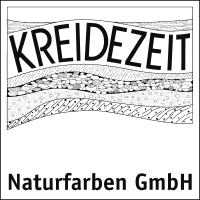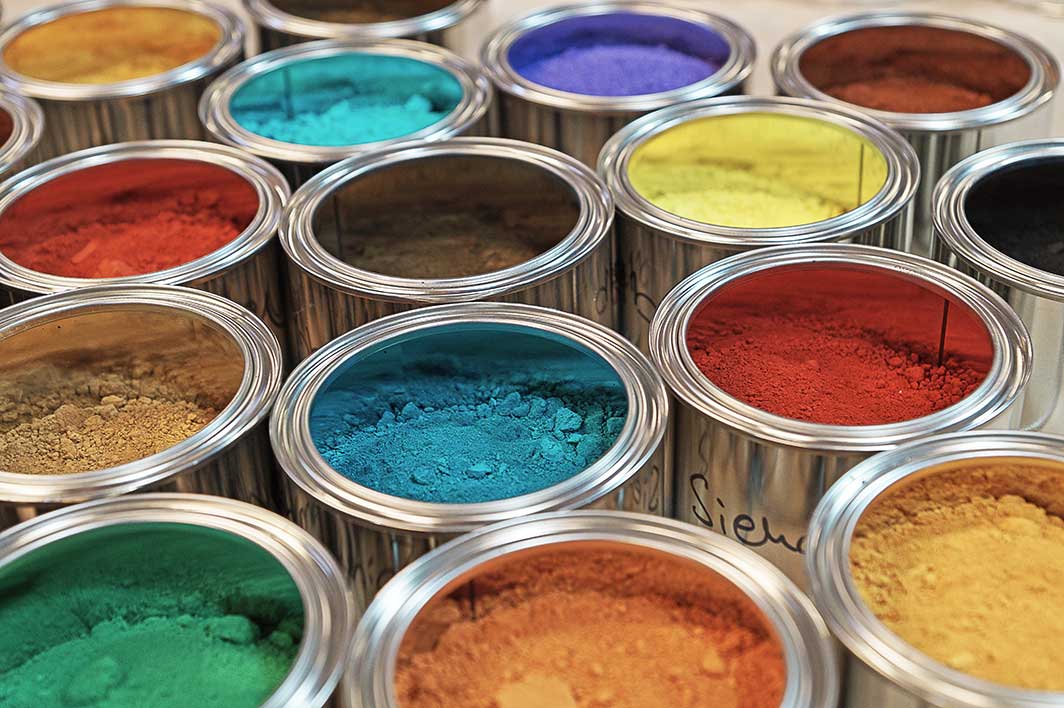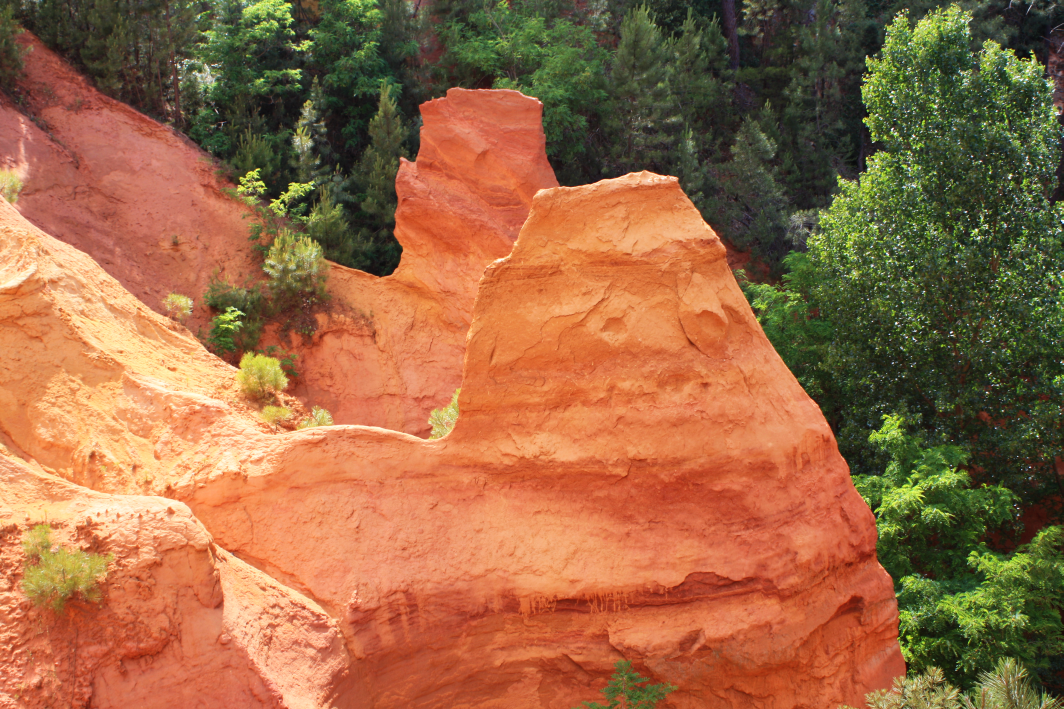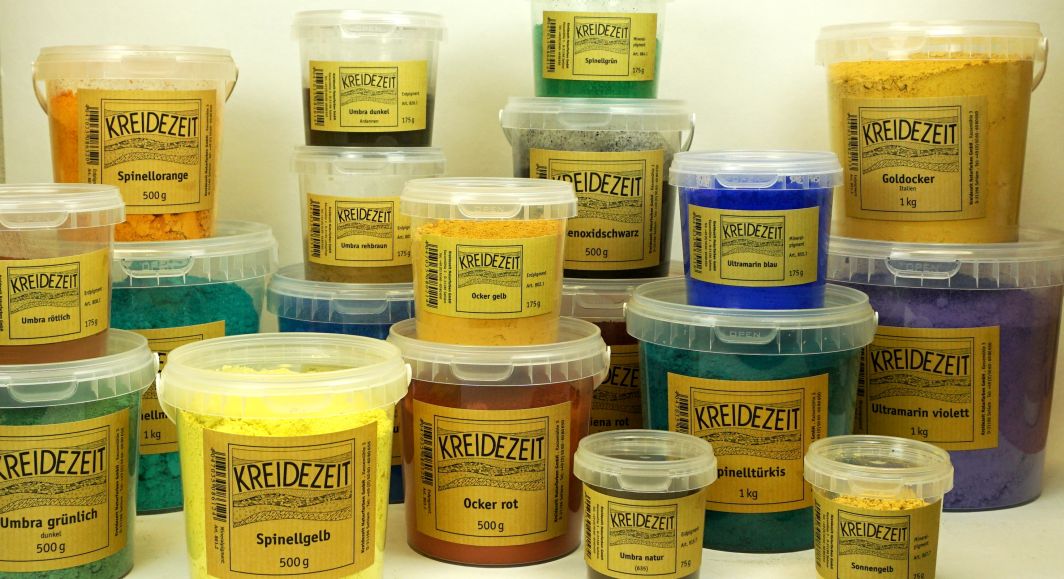KREIDEZEIT Pigments
- Are universally applicable
- Can be stored dry indefinitely
- Do not require any preservatives or other additives such as conventional colour pastes
- Are alkali-resistant
- genuine earth pigments have a special charm
- Can be mixed with each other
- Are light-fast and lime resistant
- Are compatible with all KREIDEZEIT products
For prices please ask your local dealer or importer.
At Instructions you will find illustrated descriptions of how our products are mixed with pigments.
Ochre Yellow, Ochre Gold, Ochre Orange
Product containing ferrous rocks and minerals prone to natural weathering. The colouring substance is hydrated iron oxide. The country of origin is France, but yellow ochre is widely found elsewhere on Earth.
Ochre Red
Earth pigment, produced by burning yellow ochre. The colouring components are iron(III) oxides.
Siena Red
Earth pigment, produced by burning yellow siena. Siena contains a certain amount of silicates in contrast to the ochres.
Umber Green, Dark
Mix of green mineral pigments (Spinel Green, Spinel Blue and Chromium Oxide Green) and marble powder.
Iron Oxide Pigments (yellow, orange, red, brown, black)
Pure synthetic rust, produced through precipitation reactions with aqueous ferrous sulphate solution. Very fine and extremely rich in colour. The yellow and orange tones contain iron(III) oxide with different crystallisation water content.
Iron oxide brown contains additional inclusions of iron (II) oxide. The red iron oxides are formed by water loss when heating the yellow iron oxide to temperatures of 180°C to over 800°C.
Black is a magnetic mixed oxide containing iron(II) and iron(III) oxides; it is known as magnetite in its natural form.
Especially the red iron oxide pigments can become cloudy / streaky in lime paints. However, experience has shown that they can be processed very well in plasters and fillers.
Umbers
Natural earth pigments; the colouring components are hydrated iron with hydrated manganese oxide and alumina silicates. Due to the manganese con-tent, umbers accelerate the drying process in oil-based paints. Umbers occur in various tones, depending on the iron oxide, managnese oxide and silicate content.
Ultramarine (blue and violet)
Artirfcial mineral pigments, produced by heating soda, clay and sulphur. Ultramarine tones are produced by exposure to different firing temperatures. Ultramarine Violet is a mix of Ultramarine Blue and Red. They are lime-resistant, but lime products with ultramarine tones added must be processed within 24 hours. They are non-fading and weather-resistant in themselves, but are not acid-proof. As our atmosphere today is slightly acidic, Ultramarine Blue is only suitable for limited outdoor applications (which can lead to blackening or even discolouration).
Spinel Pigments
Spinel is an oxide mineral that rarely occurs in nature. The chemical name for spinel is magnesium aluminate; in its pure form it is colourless. Due to different regional mixtures
of iron, chromium, zinc, cobalt and manganese, spinel comes in a variety of colour variations. However, these are relatively pale and weak in colour.
Spinel pigments are known as mixed-phase pigments and are manufactured by technical
means. Naturally ground spinels are mixed with metal salts (cobalt, antimony, nickel,
chromium and titanium) and exposed to temperatures between 1200 and 1600°C in an oven, where ion exchange takes place and the material is enriched with the metals until saturated. This produces very vibrant colours. The metals are incorporated into the mineral
structure so firmly that they are no longer bioavailable, i.e. they don’t break down in
the human body, during composting and when exposed to normal fires.
Spinel blue / Spinel turquoise / Spinel mint: cobalt chromium aluminates Co(Al,Cr)2O4
Spinel green: cobalt titanate (Co,Ni,Zn)(Ti,Al)2O4
Spinellgelb: Nickel-Antimony-Titanate Rutile
(Ti,Ni,Sb)O2
Spinellorange: Chrome antimony titanate rutile (Ti,Cr,Sb)O2
Sun Yellow, Spinel: is a mixture of Spinel yellow and Spinel orange.
Further Pigments
These mineral pigments must be slurried particularly carefully. However, experience has shown that they are easy to process in plasters and fillers. Especially the red iron oxides often become cloudy/streaky, especially in lime paints. These pigments are a supplement for the experienced processor.
Terra di Siena, natural
Natural earth pigment, yellow iron oxide hydrate. Occurrence in Tuscany, Corsica, Sardinia, partly in Germany: Bavaria, Palatinate and the Harz Mountains.
Terra di Siena, burnt
Natural earth pigment, burnt. The chemically bound water is expelled by the burning process. Unlike ochres, Terra di Siena contains a certain amount of silicates.
Titanium White, rutile
Obtained from a natural mineral (rutile), cleaned and precipitated again, titanium white in the rutile variety is characterised by particularly high covering power in all binders. We deliberately do not use this pigment in our wall paints, since the dumping of dilute acid in the 1980s was a major environmental issue and the avoidance of this dilute acid is the original idea of the founder of the company Kreidezeit.
Chromium Oxide Green
Chromium oxide is a chemical compound of chromium and oxygen (chromium(III) oxide, Cr2O3). Unlike chromium(VI) oxide, chromium(III) oxide is non-toxic.
It is formed by heating potassium dichromate and sulphur. Chromium oxide green is a particularly hard, lightfast, weatherproof and opaque pigment.






